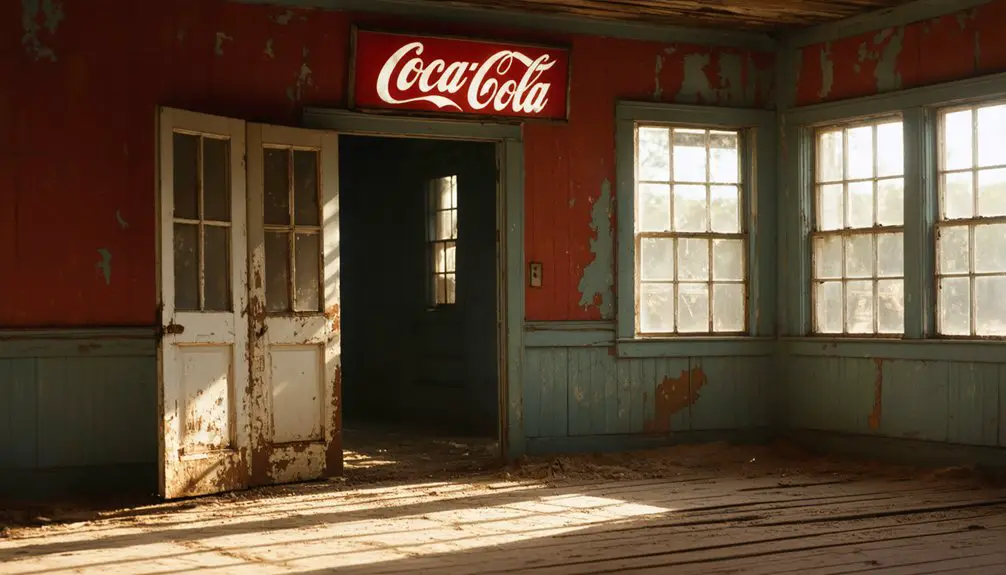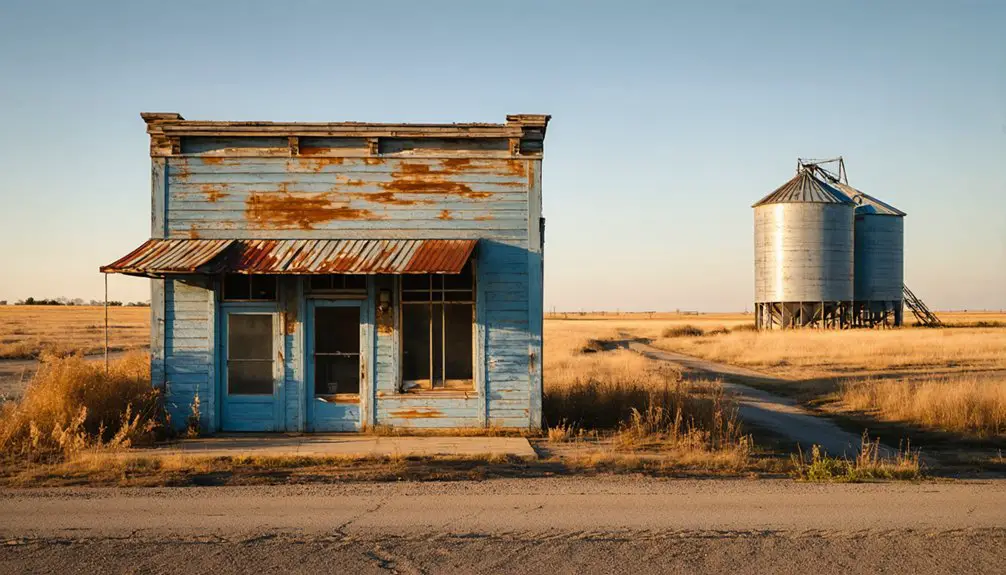You’ll find Dillard’s ghost town remnants in Carter County, Oklahoma, where it sits at 902 feet elevation. Founded in 1847 as an agricultural and trading settlement, this once-bustling community thrived on farming, mining, and transportation access before economic hardships and the Great Depression led to its decline. Today, deteriorating homes, abandoned motels, and mining waste create an eerie atmosphere, while unstable ground conditions from collapsed mines make exploration a carefully planned venture.
Key Takeaways
- Founded in 1847 as an agricultural and trading community, Dillard thrived through farming, trade, and transportation before declining into a ghost town.
- Located in Carter County at 902 feet elevation, Dillard’s landscape features deteriorating buildings, abandoned motels, and environmental hazards from mining.
- Economic decline accelerated during the Great Depression, with oil boom-bust cycles and railroad isolation contributing to the town’s abandonment.
- Mining waste and unstable ground conditions from collapsed underground mines create significant safety risks for modern ghost town visitors.
- Historical preservation efforts include cemetery maintenance, structure stabilization, and documentation through photographs and oral histories.
The Rise and Fall of Dillard
While many Oklahoma ghost towns trace their origins to the early 20th century, Dillard emerged as a settlement driven by economic prospects typical of the region’s boomtown era.
Similar to Bickford’s gypsum mining operations, Dillard established itself as a bustling industrial center. You’ll find that Dillard’s growth mirrored other Oklahoma settlements, with businesses and homes springing up as the town established itself as a crucial community hub. Like the town of Ingalls’s outlaw haven, Dillard attracted both law-abiding citizens and those seeking refuge from authorities. Local folklore suggests that the town thrived on a mix of agriculture, trade, and transportation access, drawing residents with promises of prosperity.
Community gatherings at dance halls and churches marked the town’s vibrant period. Yet, like many of its contemporaries, Dillard couldn’t withstand the changing tides of progress.
Whether due to shifting transportation routes, resource depletion, or competition from larger urban centers, the town’s decline marked the end of its boom years.
Life in Early Settlement Days
During Dillard’s early days, you’d have found pioneers living in basic dwellings built from locally sourced materials, including sod houses and simple wood-frame structures that offered minimal protection from harsh weather conditions. These settlers faced challenges similar to those who participated in the Land Run of 1889 to establish new communities across the territory.
Trading activities centered around essential goods, with settlers exchanging agricultural products and livestock at small general stores that served as community hubs. The scarcity of resources meant settlers often paid inflated prices for basic necessities like yellow Cimarron water.
You’d have witnessed regular commerce between farmers, ranchers, and merchants who relied on the newly established railroad connections to move their goods to larger markets.
Pioneer Housing Structures
Pioneer homes in Dillard’s early settlement days reflected both the resourcefulness of settlers and the abundant natural resources of the area.
The pioneer architecture primarily featured wood-frame construction, with many families starting in simple log cabins before advancing to more permanent I-house designs. You’d find these early building materials sourced directly from local timber, paired with basic stone or concrete foundations to protect against ground moisture. Similar to the historic Dillard-Lawson House, indoor plumbing was a rare luxury that only the most prosperous settlers could afford. Compared to today’s average home size of 1,860 square feet, these pioneer dwellings were notably compact.
As your family grew or prospered, you might’ve added outbuildings or guest cabins to accommodate extended family or visitors.
The practical layouts typically included two stories with multi-purpose rooms, centered around essential fireplaces for cooking and heating. Most homes featured modest windows and functional porches, while basements provided vital storage space and shelter during Oklahoma’s extreme weather conditions.
Early Trading Activities
As French traders ventured into northern Oklahoma via the Arkansas River in the early 1700s, they established essential trading networks that would shape the region’s economic foundation.
You’d have found these early trading dynamics centered around strategic river confluences, where posts facilitated commerce between European settlers and indigenous peoples. These locations were critical meeting points, similar to how Coffee’s Post emerged as a major trading landmark in 1829.
The Wichita Indians played a significant role in these exchanges, trading furs and hides for Euro-American manufactured goods. The arrival of trader Paul Lignest Chouteau in 1802 marked the establishment of the first documented trading post near present-day Salina.
Economic Forces Behind the Decline
You’ll find that Dillard’s economic fortunes followed the volatile boom-bust pattern common to Oklahoma oil towns in the early 1900s.
Like many mining and boomtowns across Oklahoma, Dillard faced challenges when local natural resources were depleted.
Similar to many towns during the Great Depression, Dillard experienced a devastating economic downturn that accelerated its decline.
The town’s isolation from major railroad routes severely limited its ability to transport oil and other goods efficiently to wider markets.
When oil production declined and transportation challenges persisted, Dillard couldn’t sustain its local economy, leading many residents to seek opportunities elsewhere.
Oil Boom Bust Cycle
When oil was discovered near Dillard in the early 20th century, the town experienced a dramatic economic transformation that would ultimately seal its fate. The rush of oil exploration brought an influx of drilling companies, workers, and rapid infrastructure development, but this growth masked a critical lack of economic sustainability.
You’d have seen the town’s fortunes rise and fall in lockstep with oil prices and production levels. As wells gradually depleted and global market forces triggered price volatility, Dillard’s mono-industry economy couldn’t adapt.
The Great Depression and post-WWII energy shifts further destabilized the local oil industry. Without economic diversification, each market downturn hit harder than the last. When production finally dwindled, the exodus began – businesses closed, services vanished, and property values collapsed, leaving Dillard a shell of its former self.
Railroad Route Changes
The dramatic reshaping of Oklahoma’s railroad network dealt Dillard another devastating economic blow during the mid-20th century.
As you examine the area’s railroad history, you’ll find that widespread line abandonments swept across the state, with over 2,000 miles of track removed. These transportation shifts weren’t random – they reflected deep economic changes that transformed America’s heartland.
You would’ve seen this unfold as trucks and pipelines replaced trains for shipping goods, while passenger service dwindled in the face of growing automobile use.
The Great Depression had already weakened many rail lines, and by the 1960s, the modernization to diesel engines couldn’t save unprofitable routes.
When larger carriers like Union Pacific began absorbing smaller railroads, they cut redundant lines, further isolating communities like Dillard.
What Remains Today
Modern-day Dillard stands as a haunting indication of environmental disaster, with several deteriorating homes, empty service stations, and abandoned motels dotting its landscape.
You’ll find rusty signage and broken windows creating an eerie atmosphere throughout the abandoned structures, while concrete foundations reveal the town’s former layout.
The site faces severe environmental hazards from extensive mining waste and chat piles.
You’ll encounter unstable ground conditions from collapsed underground mines, making exploration dangerous.
While the Quapaw Marshal’s Office remains operational, most buildings stand empty.
The town’s official dissolution followed government buyouts around 2009, leaving minimal human activity except for cleanup crews.
Today, you’ll mainly find ghost town enthusiasts and photographers documenting the remnants of this once-thriving community.
Notable Historical Events

Founded in 1847, Dillard emerged as a modest agricultural community within Indian Territory, serving as an essential trading post for Native American populations and early settlers.
In the untamed expanse of Indian Territory, Dillard arose as a vital bridge between Native peoples and pioneer settlers.
The town’s historical significance is marked by several pivotal events that shaped its cultural heritage:
- Oklahoma’s shift from Indian Territory to statehood in 1907 transformed Dillard’s governance and land ownership patterns.
- The arrival of railroad infrastructure in the late 19th century initially promised economic growth but ultimately bypassed the town.
- Agricultural mechanization and the Great Depression triggered widespread rural exodus, drastically reducing the population.
- The closure of the post office marked the town’s official decline into ghost town status, reflecting broader changes in rural Oklahoma’s landscape.
Geographic and Environmental Impact
Situated at an elevation of 902 feet above sea level in Carter County, Oklahoma, Dillard’s geographic footprint reveals a complex interplay between human settlement and environmental transformation.
You’ll find evidence of the town’s railroad origins in the landscape, where tracks once shaped local ecosystems through land clearing and altered water flow patterns.
Natural hazards like tornadoes, floods, and wildfires have influenced the area’s environmental reclamation, while geographic influences such as rolling plains determined early settlement patterns.
Today, the semi-abandoned site showcases mixed features of natural regrowth and human impact. Without maintained infrastructure, you’ll notice increased erosion risks and patchy ecological succession.
The land has largely evolved to a combination of agricultural use, fallow fields, and naturally reclaimed spaces, though some areas still bear traces of potential resource extraction activities.
Preserving Dillard’s Legacy

As ghost towns across Oklahoma face increasing threats from development and decay, preservation efforts for Dillard focus on multiple fronts to safeguard its historical legacy.
You’ll find various preservation strategies in place, supported by dedicated community engagement from historical societies and local volunteers.
- Extensive documentation through photographs, written records, and oral histories captures Dillard’s story for future generations.
- Physical preservation includes cemetery maintenance and stabilization of remaining structures.
- Educational exhibits at museums showcase Dillard’s cultural impact through multimedia presentations and artifacts.
- Online platforms enable broader public participation in preservation efforts while promoting responsible site visitation.
The Oklahoma Historical Society continues to coordinate with landowners and preservation groups to protect Dillard’s remaining sites, ensuring this piece of Oklahoma’s heritage isn’t lost to time.
Frequently Asked Questions
Were There Any Famous Outlaws or Lawmen Associated With Dillard?
You won’t find any famous outlaws or notorious lawmen tied to this location – historical records show it was primarily an oil boomtown rather than a hub for criminal or law enforcement activity.
What Native American Tribes Lived in the Dillard Area Before Settlement?
While settlers thought they’d “discovered” new land, the Choctaw, Wichita, and Potawatomi tribes had rich tribal history there. Each nation brought distinct cultural significance before white expansion disrupted their ancestral territories.
Did Dillard Have a Newspaper, and Do Any Copies Survive?
You won’t find any evidence of a dedicated Dillard newspaper. Instead, you’d have found news about Dillard in *The Daily Ardmoreite*, which began in 1893 and still has surviving copies in Oklahoma’s archives.
Are There Any Documented Paranormal Activities or Ghost Stories?
Imagine walking through time’s ghostly veil… While there aren’t any officially documented haunted locations or ghost sightings from Dillard, nearby Oklahoma ghost towns share similar paranormal patterns of unexplained voices and apparitions.
What Happened to the Cemetery Records From Dillard’s Active Years?
You’ll find most of the original cemetery records were lost due to poor preservation efforts and inconsistent documentation. Historical record accuracy suffered from the town’s decline and absence of centralized archival management.
References
- https://en.wikipedia.org/wiki/List_of_ghost_towns_in_Oklahoma
- https://www.okhistory.org/publications/enc/entry?entry=GH002
- https://okmag.com/blog/a-ghostly-site/
- https://kids.kiddle.co/List_of_ghost_towns_in_Oklahoma
- http://sites.rootsweb.com/~oktttp/ghost_towns/ghost_towns.htm
- https://z94.com/ghost-town-ingalls-oklahoma/
- https://www.youtube.com/watch?v=5d-wHDTIbb0
- https://www.youtube.com/watch?v=-jYN1_E2VV0
- https://web.viu.ca/davies/H321GildedAge/HarpersW.TheRushToOklahoma.1889.htm
- https://en.wikipedia.org/wiki/History_of_Oklahoma



